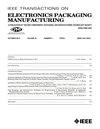Study of 6 mil Cu Wire Replacing 10–15 mil Al Wire for Maximizing Wire-Bonding Process on Power ICs
IEEE Transactions on Electronics Packaging Manufacturing
Pub Date : 2010-04-01
DOI:10.1109/TEPM.2010.2045760
引用次数: 9
Abstract
Copper (Cu) wire-bonding with its advantage in cost, mechanical enhanced characteristic, and better electrical performance is a developing alternative interconnection technology to replace gold (Au) and aluminum (Al) wires in IC packaging manufacturing. This paper discussed the experimental study of using 6-mil Cu wire on an ASM wire bonder to replace 10-15 mil Al wire in a power IC device. It encompassed wire and tool selection, wire-bonding process development, post wire-bonding integrity inspection, and bonding reliability results. The wire and tool selection included type of wire, capillary use, and bonder capability. The process development focused on two crucial stages, Free air ball (FAB) formation and bonding process window development. Design of experiment (DOE) was extensively applied in this study. The experimental studies showed that flow rate of forming gas was a key factor to form the qualified FABs and establishment of a workable process window. Wire pull and ball shear tests were conducted per JEDEC criteria for bond strength integrity. Moreover, crater test and Zygo's 3-D measurement were used to inspect any risk of underlying metal integrity in die before reliability tests. The data showed that sufficient thickness of the Al bond pad was crucial to avoid any underlying metal damage when subjected to heavy copper wire bonding forces. High-temperature baking (HTB) and pre-condition (PC) and temperature cycle (TC) were used to evaluate the samples reliability. The results of the two reliability tests showed that Cu/AL intermetallic compound (IMC) growth was slow, which indicates potential significant product life-span extension. The study concluded that with current thermosonic ball bonder, using 6-mil Cu wire could replace heavy 10-15 mil Al wire in power IC applications.6mil铜线取代10 - 15mil铝线的研究,以最大限度地提高电源集成电路的线键合工艺
铜(Cu)线键合具有成本优势、机械增强特性和更好的电气性能,是IC封装制造中替代金(Au)线和铝(Al)线的一种新兴互连技术。本文讨论了在ASM焊丝机上使用6mil铜线代替功率IC器件中10- 15mil铝线的实验研究。它包括线材和工具的选择、线材粘合工艺的开发、线材粘合后的完整性检查以及线材粘合可靠性结果。电线和工具的选择包括电线的类型,毛细管的使用和粘合能力。工艺开发集中在两个关键阶段,自由空气球(FAB)的形成和键合工艺窗口的开发。实验设计(DOE)在本研究中得到了广泛的应用。实验研究表明,成形气体的流量是成形合格fab和建立可行工艺窗口的关键因素。根据JEDEC的粘结强度完整性标准进行了拉丝和球剪试验。此外,在可靠性测试之前,还使用了凹坑测试和Zygo的3d测量来检查模具中潜在金属完整性的任何风险。数据表明,当受到较大的铜线结合力时,铝键合垫的足够厚度对于避免任何潜在的金属损伤至关重要。采用高温烘烤(HTB)、预条件(PC)和温度循环(TC)评价样品的可靠性。两种可靠性试验结果表明,Cu/AL金属间化合物(IMC)生长缓慢,表明产品寿命可能显著延长。该研究得出结论,在目前的热超声球键合机中,使用6mil的铜线可以取代功率IC应用中10- 15mil的铝线。
本文章由计算机程序翻译,如有差异,请以英文原文为准。
求助全文
约1分钟内获得全文
求助全文

 求助内容:
求助内容: 应助结果提醒方式:
应助结果提醒方式:


